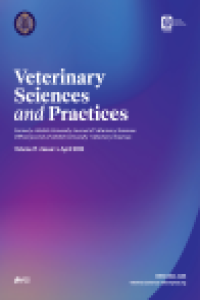Adrenalin, Motilite, Noradrenalin, Sindirim kanalı, Reseptörler
The role of catecholamines in maintenance of homeostasis in digestive tract of domestic animals
___
- Adams R.H., 2001. Veterinary pharmacology and therapeutics. The Iowa State University Press, Ames, 8th edition.
- Aronson J.K., 2000. Where name and image meet-the argument for adrenaline. British Journal of Pharmacology 320, 506-509.
- Bardou M., Dousset B., Deneux-Tharaux C., Smadja C., Naline E., Chaput J.C., Naveau S., Manara L., Croci T., Advenier C., 1998. In vitro inhibition of human colonic motility with SR 59119 and SR 59104A: evidence of a β3-adrenoceptor-mediated effect. Eur J Pharmacol 353: 281-287.
- Brown K.J., Summers R.J., 2001. β1- and β3-adrenoceptor mediated smooth muscle relaxation in hypothyroid rat ileum. Eur J Pharmacol. 415, 257-263.
- De Ponti F., Giaroni C., Cosentino M., Lesshini S., Frigo G., 1996. Adrenergic Mechanism in the Control of Gastrointestinal Motility: From Basic Science to Clinical Application. Pharmaco. Ther. 69, 1, 59-78.
- Božić T., 2012. Patološka fiziologija domaćih životinja. Drugo izdanje, Beograd, 237- 240.
- Ćupić V., Muminović M., Kobal S., Velev R., 2014. Veterinarska farmakologija. Beograd, Sarajevo, Ljubljana, Skoplje, Narodna biblioteka Srbije, Beograd, 291-294, 304-305.
- Daly C., Mc Cafferty D.; Roberts M., 2002. Introduction to Adrenoreceptors.
- Guyton A.C., Hall J. E., 2003. Medicinska fiziologija. Deseto izdanje, Medicinska naklada, Zagreb.
- Hadžović S., 1998. Neurofarmakologija domaćih životinja. Sarajevo.
- Hadžović S., Muminović M., 2001. Organofarmakologija domaćih životinja. Sarajevo.
- Hodžić A., Hamamdžić M., 2012. Endokrinologija domaćih životinja. Univerzitetski udžbenik, Sarajevo, 19-38, 92-94.
- Hutchinson D.S., Evans B.A., Summers R.J. , 2001. β1-adrenoceptors compensate for β3-adrenoceptors in ileum from β3-adrenoceptor knock-out mice. Br J Pharmacol. 132, 433-442.
- Katica M., 2015. Presence of Adrenergic Recptors in the Wall of Caecum During Turkey Fattening Phase., International Congress „One World-One Health-One Vision, Sarajevo, Bosnia and Herzegovina, Book of Abstracts, 113-115.
- Manara L., et all., 2000. Functional assessment of ¬ adrenoceptor subtypes in human
- colonic circular and longitudinal (taenia coli) smooth muscle. Gut, 47, 337-342, 129.
- Mujezinović I., 2007. Doktorska disertacija. Veterinarski fakultet, Univerzitet u Sarajevu.
- Muminović M., 1991. Ispitivanje djelovanja fiziološki i farmakološki aktivnih supstancija i nekih njihovih antagonista na rumen goveda u cilju unapređenja farmakoterapije. Doktorska disertacija, Univerzitet u Sarajevu.
- Oriowo M.A., 1995. Different atypical beta-adrenoreceptors mediate isoprenaline-induced relaxation in vascular and non-vascular smooth muscales. Life Sci , 56, 269-275.
- Rang H.P., et all., 2007. Rang and Dale’s Pharmacology, Churchil Livingstone, Sixth edition.
- Roberts S.J., Papaioannou M., Evans B.A., Summers R.J., 1999. Characterization of β- adrenoceptors mediated smooth muscle relaxation and the detection of mRNA for β1 - β2 – and β3 – adrenoceptors in rat ileum. Br. Journal Pharmacol. 127, 2549-2556.
- Siegel G.J., 1999. Basic Neurochemistry. Molecular cellular and medical aspects, Lippincott Williams and Wilkins, Part II. Sixth edition.
- Živančević-Simonović S., Đukić A., Đurđević P., Jurišić V. I Mijatović Lj., 2006. Opšta patološka fiziologija. Univerzitet u Kragujevcu, Medicinski fakultet, Srbija,106-122; 144-1451.
- Başlangıç: 2022
- Yayıncı: Atatürk Üniversitesi
Latif Emrah YANMAZ, Elif DOĞAN, Zafer OKUMUŞ, Mahir KAYA, Mümin Gökhan ŞENOCAK, Seyda CENGİZ
Muhamed KATICA, Amela KATICA, Nadzida MLAĆO
Saksağan (Pica pica)’da Pancreas Dokusunun Morfolojik İncelenmesi
Devriş ÖZDEMİR, Zekeriya ÖZÜDOĞRU, Hülya BALKAYA, Hülya KARA, Emre ERBAŞ
Mehmet KÖSE, Şükrü DURSUN, Bülent BÜLBÜL, Mesut KIRBAŞ, Uğur DEMİRCİ
